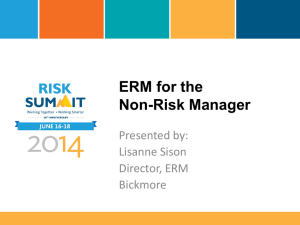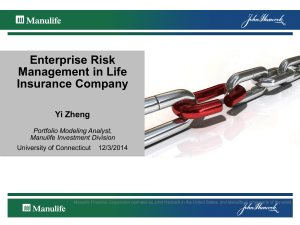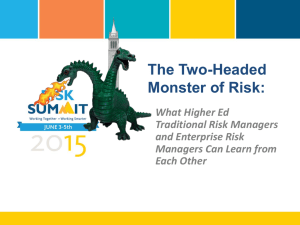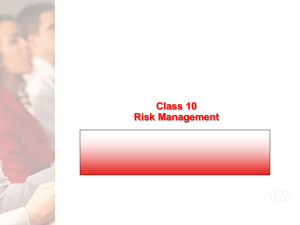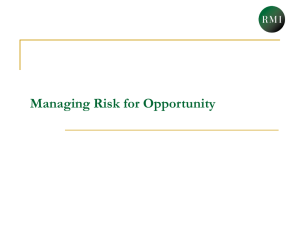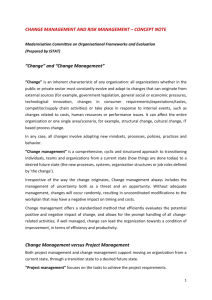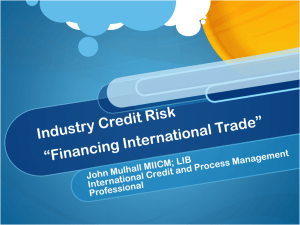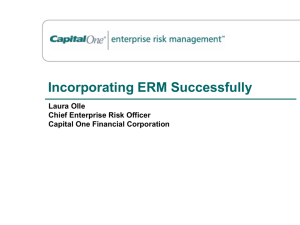Tamer Saka - International Istanbul Insurance Conference
advertisement
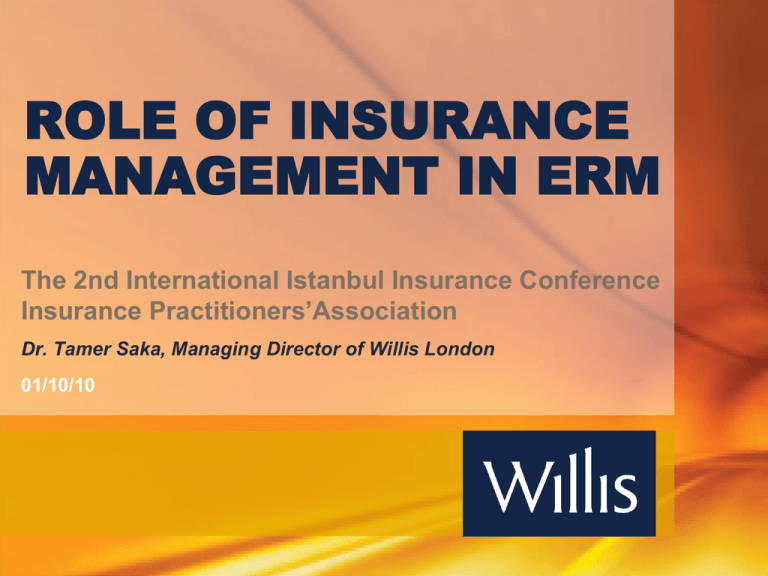
ROLE OF INSURANCE MANAGEMENT IN ERM The 2nd International Istanbul Insurance Conference Insurance Practitioners’Association Dr. Tamer Saka, Managing Director of Willis London 01/10/10 AGENDA 1. What is Enterprise Risk Management ? 2. Why is Enterprise Risk Management Important? 3. Process of Risk Management 4. Role of Insurance Management in ERM 2 Risks are embedded throughout the businesses. ‘Playing safe is probably the most unsafe thing in the world. You cannot stand still. You must go forward. ’ Robert Collier, 1885 – 1950 3 Risk management failure has been the cause of most recent industry losses. Missing the underlying issues – management problems, control weaknesses, failing models – can lead to adverse financial impact and reputational damage to the Company. 4 Enterprise Risk management is a ... “process, effected by an entity’s board of directors, management and other personnel, applied in strategy – setting and across enterprise, designed to identify potential events that may affect the entity, and manage risk to be within its, risk appetite to provide reasonable assurance regarding the achievement of entity objectives.” 5 Elements of Enterprise Risk Management A process, ongoing and flowing through an entity Effected by people at every level of an organization Applied in strategy setting Applied across the enterprise, at every level and unit, and includes taking an entity level portfolio view of risk Designed to identify potential events affecting the entity and manage risk within its risk appetite Able to provide reasonable assurance to an entity’s management and board Geared to the achievement of objectives in one or more separate but overlapping categories – it is a means to an end, not an end in itself 9 Why is Enterprise Risk Management Important ? ERM makes your business more ‘visible’. Are we taking the right risks? Are we taking the amount of risks? right Do we have the right processes to manage risks? 6 Why ERM ? Are we aware of our risks and do we prioritize them? Are we taking the right risks? How are our risks related to our targets and goals? Do these risks add value to our business, bring in competitive advantage? Do we recognize that business is about taking risks and do we make conscious choices concerning these risks? Are we getting a return that is consistent with our overall level of risk? Does our organizational culture promote or discourage the right level of risk taking a Are we taking the right amount of risks? activities? Do we have a well defined organizational risk appetite? Has our risk appetite been quantified in aggregate and per occurrence? Is our actual risk level consistent with our risk appetite? Are our risk management processes aligned with our strategic decision-making process and existing performance measures? Do we have the right processes to manage risks? Are our risk management processes coordinated and consistent across the entire enterprise? Does everyone use the same definition of risk? Do we have gaps and/or overlaps in our risk coverage? Is our risk management process cost effective? 7 ERM is The Most Cost-Effective Strategy for… Improved Business Performance Optimize Risk Management Cost Competitive Advantage Reduced Surprises and Losses Regulatory Compliance Protected Reputation and Brand Image Aggregate Risk Transfer and Acceptance Management of Enterprise-wide Risks 8 ERM Scope Business Continuit y Social Respon sibility Insuranc e Reputatio n and Brand Mng. Environ ment Health ERM Engineeri ng Standard s Crisis Manage ment Legal and Complian ce Workers ’ Health and Safety Security Financia l Risk Manage ment Informat ion Security 10 Critical Success Factors Be empathetic to Business People, Help to implement actions Focus on both “opportunities” and “threats”, not only on threats! Recommendations must be practical and down to earth Focus on quantifiable and easy to understand benefits first (insurance, IT security, brand etc.) Systematic and continuous, disciplined risk management activities Try to show your value in terms of $ Implementing risk management based performance measurement Acceptance and commitment from the mid-level managers 10 Risks We Face Are Enormous Finansal Risks Operational Risks External Risks Customer Satisfaction Foreign Currency Human Resources Brand Management Competitor Interest Rate Product/Service Dev. Information Technology Legal and Efficiency Information Security Capacity Pricing Credit Process Mng. Employee Commitment Shareholder Financial Instruments Partnership Tax Political Concentration Authority and Limit Business Interruption Supply Insurance Prod/Serv.Quality Performance Management Customer Trends Equity Price Env. Health Communication Change Mng. Liquidity Investment Portfolio Commodity Price Workers’ health and Safety Compliance Economical Natural Disasters Strategic Risks Investment Evaluation Budget and Planning Business Model Organizational Structure Industrial Business Portfolio 11 Process of Risk Management 1 2 3 13 Alternative Risk Management Strategies Exploit Transfer Allocate Insure Diversify Reinsure Expand Hedge Create Securitize Redesign Share Reorganize Outsource Price Indemity Arbitrage Retain Influence Accept Avoid Reprice Self Insure Divest Prohibit Offset Plan Stop Target Reduce Screen Eliminate Disperse Control 13 Insurance Risk Management RISKS CLAIM COVERAGE 14 Insurance Management as a Part of ERM Step-1 Developing Common Risk Universe and Risk Management Policies and Procedures Step-2 Identification of risks which organization currently faces (Internal-External, FinancialOperationalStrategic, Pure-Speculative etc) Step-3 Identification of Current Level of Risks (Exposure, Volatility, Probability, Impact, Time Horizon, Correlation, Capital, Business Plans…etc) as HighMedium-Low or Acceptable-No acceptable etc. Step-4 Defining of Risk Tolerance Levels Step-5 Defining and Analyzing of the Gap Between Current Level of Risk and Company’s Risk Tolerance Levels Step-6 Developing of Risk Management Solutions to be able to reduce gaps to desire levels (Cost of Risk & Benefit of Solutions) 14 Insurance Management as a Part of ERM Step-7 Defining of needs of Insurance types (All Risk PD/BI, Liabilities, Marine&Cargo, Terrorism, Theft…etc) Step-8 Defining of Basic Elements of Program Structure (Values, Limits and Retentions) in line with outputs of Steps 4 and 6. Step-9 Defining of Wordings (Terms and conditions and clauses) Step- 10 Selection of Insurer (Industry Rating, Claims Settlement ability, Sustainability of the company, Service levels & infrastructure etc) Step-11 Choice of Intermediary (Representation of the insurance market, Knowledge of insurance amongst all industry segments, Service levels & infrastructure, Transparency and Trust…etc) Step-12 Issuing Individual Policies Step-13 Continuously Review and Monitor. (Existing Risk Control Measures Review. Risk inspection Risk Audit 14 Insurance Management as a Part of ERM STEPS 1 To 6 are relatively new perspective to managing insurable risks as a result of developments in ERM STEPS 7- 13 Traditional approach 14 Conclusion: Effective ERM can help organizations to; 1- better identify and prioritize risks 2- better link between risk management and insurance management 3- better risk management coordination between different locations, business units or departments 4- better understand “Aggregated Risks Exposure” 5- develop integrated insurance programs 6- have a systematic approach to manage insurances 7- saving money by better understanding risks and avoid unnecessary policies and create firm wide policies. 8- achieve lower P/L ratios 9- increase over risk ownership cross the organization 10-have better risk profile and have much better relationships with Insurance Markets 14 Thank You … Dr. Tamer Saka Managing Director Willis London




